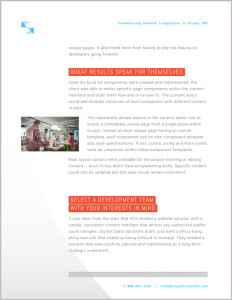
Recently, we’ve received numerous inquiries from folks asking us to create a case study for their company. While we are perfectly happy to do so, I thought we’d offer a few tips on how to get started.
 What Is A Case Study?
What Is A Case Study?
An account of how your product, service, or solution helped a customer improve results or resolve a problem is usually referred to as a case study. Often presented as a blog post or short, downloadable PDF, these documents are a great way to promote your business or services because you can cite real-world examples and leverage the powerful storytelling format. They also let you demonstrate your experience solving the kinds of challenges your prospects often face.
But, don’t conflate a case study with a traditional product brochure that features straightforward marketing copy. Some advantages a case study may be more uniquely able to deliver may include:
- Use of real world challenges and client stakeholders (Authentic accounts resonate well.)
- A familiar storytelling aspect. (Readers crave stories!)
- “Social proof” credibility. (“They” tried it. Why should we miss out on similar results?)
A compelling case study can help you earn the trust of a prospective customer who may not be familiar with your company. They are sometimes used to help client stakeholders justify your solution to upper management at their organizations. Evidence that you were able to help another real-world client affords you credibility that might otherwise be hard to build.
Start Building Your Story With These Steps
If you think you have a useful customer story to tell, get busy! Here are a few ideas to get the process moving:
1. Sketch Your Outline
Begin by creating an outline of your case study. At its most basic, the structure will be “challenge” and “solution.” But it will expand from there.
 2. Tap A Key Person From The Client Team
2. Tap A Key Person From The Client Team
If possible, draft one of the clients involved in the story you want to tell. If you can gain buy-in and/or participation of a key stakeholder on the client side, you may be able obtain great quotes that will support your case study. Remember, a case study also provides your client’s brand or business with an opportunity for exposure. So they might be more inclined to participate than you might think. One key here is to take on the heavier lifting involved in the process. The easier you make it for them to assist, the more likely they will.
3. Introduce The Client’s Business
Include a brief description of the client’s business and the high-level challenges they face on a regular basis.
4. Lay Out The Key Challenges
“Tee up” the specific challenges the client’s company faced. If you can frame this section from the client’s point of view, it’s more likely to resonate with your audience. You want your readers to feel “I’ve been there. I’ve faced that. That’s a difficult situation.”
5. Explain How You Solved Those Problems
Once the main challenges are clear, recount how your team solved the client’s quandary. Here you can proceed step-by-step, making sure to emphasize where your solution directly helped solve their business issue.
 6. Emphasize “Aha” Moments
6. Emphasize “Aha” Moments
If there was a key breakthrough, emphasize that. It could serve as the dramatic turning point in your case study story. For example, I recently interviewed a business leader for a case study. I was having some trouble honing-in on the precise catalyst that drove his team to find a solution for their client. It seemed like there were so many problems to solve. But deeper in conversation, he mentioned that his client expressed a desire to “break the cycle of crisis” that was happening in their offices each day. Instantly, I’d found a great hook for the story. Ask good questions, listen well, and take good notes so you can, too.
7. Remind Readers Why The Client Chose You
Describe why your team or product was uniquely positioned to resolve the client’s business challenges.
8. Weave Direct Quotes Into Your Story
This will reinforce #2 above. Include quotes from client stakeholders involved in that particular initiative whenever possible. These quotes often work like testimonials and can really breathe life into your Case Study.
“The ability to find the exact right words to tell your company’s story isn’t an easy feat, and it’s even harder to do so consistently.” —Hubspot
 9. Leverage Visuals and Hard Numbers
9. Leverage Visuals and Hard Numbers
Include images and/or real numbers where possible. If your solution helped a client significantly boost the response rate to a marketing effort, say so! If an email campaign or web initiative helped materially improve site traffic or revenues, present any analytics data you think can help support that point.
10. Summarize The Results
Lay out the final results both in terms of benefits to your company and to the customer’s business. It’s fair to express that the collaboration was mutually beneficial. But try to avoid hyperbolic phrases that might compromise credibility.
Bonus Tips
Definitely optional, but you can also revisit the same customer months later and post an update to your case study. Remember that case studies have potential to be repurposed into videos, podcasts, and infographics.
 Don’t Have An Actual Customer Story Yet? Invent One!
Don’t Have An Actual Customer Story Yet? Invent One!
You won’t always have access to a customer’s experience that can be shaped into a story. Sometimes your product, service, or offering is simply too new to have one. Well, fear not. In those instances you can invent a likely scenario and call it a “Business Use Case.” While typically not as compelling as a real-life account, a business use case can still help prospective customers envision real scenarios where your offering would be effective.
Ask Us To Generate A Case Study For You
Yes folks — we’re happy to help. Another upside for you is, we’re fairly well practiced at this. We’re ready to hear about your products, services, and goals — then quickly spin those ideas into a case study or business use case designed to engage, build interest, and encourage your prospects to become customers.
Collaborate with Spark Creative and we’ll lead you through an organized process that will result in succinct, compelling case studies that address your prospect’s biggest challenges and consider your top-line business goals. Contact us today!



